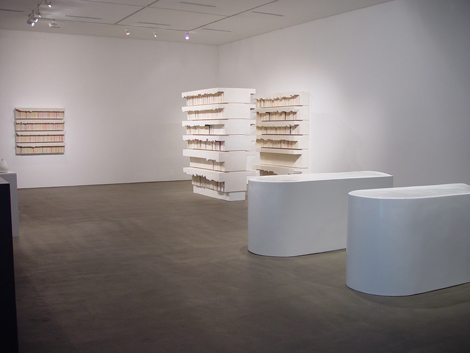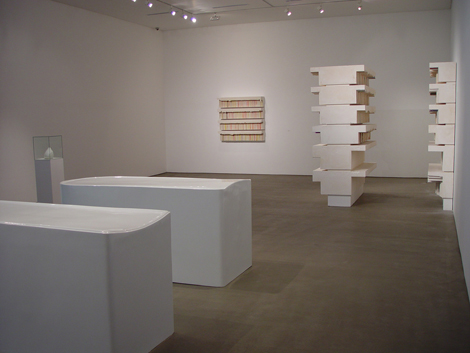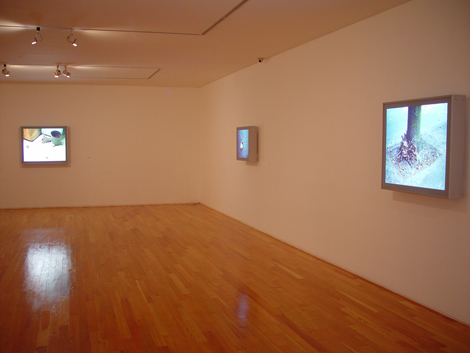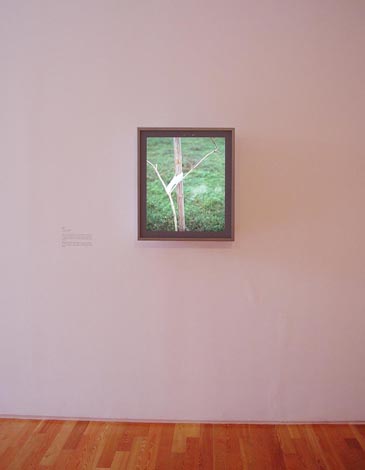Kukje Gallery is presenting photographer Jeff Wall and sculptor Rachel Whiteread to open the fall season in 2002. Jeff Wall's early work has been presented in Korea previously, first in 1994 at the National Museum of Contemporary Art and later at the Kwangju Biennale in 1995. And for Rachel Whiteread this is the first introduction of her work in Korea. Although the presentation of the two artists occupies separate exhibition spaces, there is a strong resonance throughout the exhibition in the way both artists take familiar and everyday objects and imagery as raw material to transform these into potent metaphors. The exhibition presents 10 pieces by Whiteread and 7 photographs by Wall.
Rachel Whiteread was the recipient of the prestigious Turner Prize in 1993 and represented Britain at the Venice Biennale in 1997. As a younger artist in her late thirties she is currently one of the most prominent and widely acclaimed sculptors.
Whiteread's work is simple and clear, sensitive and intelligent. She produces sculptures that take their shapes from such everyday household objects as the bed, bathtub, kitchen sink, bookshelf, vase etc. Whiteread first began casting negative space of a closet as she was experimenting with means of expressing in sculptural form her childhood experiences of sitting inside a dark closet--the comforting darkness that fully enveloped her was the essence that Whiteread aimed to capture in her early work.
Whiteread translates the void, the emptiness, the intangible into solid mass using plaster, bronze, and resin, and gives form and shape to hidden spaces, to the intangible. The artist presents new information about our world in her cast objects that are loaded with traces of everyday human life. The bare simplicity of her minimal sculptures is always a sign of life and death.
The work Untitled ; Trafalgar Square Plinth is a model of the public monument that Whiteread installed on one of the plinths at London's Trafalgar Square in 2001. She produced a transparent replica of the existing Victorian era plinth and turned it upside down. This simple and lucid shape was able to capture the imagination of viewers and was a highly popular and successful art project. With perfect equipoise, its inherent dualism of light and dark, weight and airiness, solid and translucency suggests further dichotomies like heaven and earth, corporeal and spiritual, obscure and lucid.
In her recent commissioned public sculptures Whiteread has been able to fuse monumentality with everyday simplicity, and her sensitivity to the specifics of a given site has contributed to the recognition of Whiteread as the most seminal sculptor in recent years The Canadian born photographer Jeff Wall was the first artist to use a light box in presenting photography in 1977. He notes of himself as "a painter of modern life". As a critic and art historian Wall's photographs are closely determined by the conventions of painting and cinema, and his work engages the viewer with issues of representation in photography and the photographed imagery as social codes. Wall is one of the most critically acclaimed photographer who has held retrospective exhibitions at the Museum of Contemporary Art in Chicago (1995), Jeu de Paume (1995), Museum of Contemporary Art in Helsinki (1996) and Whitechapel Gallery in London (1996), among others.
Jeff Wall's photographs stand out in any exhibition. His photographs are "installed"--the film is fixed onto a light box. The light, the glow emanating from the photograph absorbs and attracts the viewer's gaze. Despite its mundane subject matter and the fact that photography is a medium that can be mechanically reproduced, Wall's work has aura.
At first glance, Wall's photographs seem like snap shots but his images are actually carefully calculated and staged compositions. Whether it is an elaborate staging of a grand epic drama or a humble interior scene as in Diagonal Composition, nothing that enters the camera frame is left to arbitrary chance. Contrary to the perception of photography as a technical and faithful reproduction of reality, Wall is producing images of reality that are as composed as painting. Wall attempts to produce photographs that are made up of pure signs, devoid of ambiguity, chance and uncertainty.
국제갤러리는 2002년 가을을 여는 첫 전시로 세계적인 영국의 여성 조각가 레이첼 화이트리드(Rachel Whiteread)와 캐나다 출신의 남성 사진 작가 제프 월(Jeff Wall)의 2인전을 갖는다.
제프 월은 1994년 국립현대미술관의 [까르띠에 소장품전]과 1995년 광주비엔날레를 통해 그의 초기 사진이 몇 점 국내에 처음 소개된 바 있으나 그 이후 국내에 전시될 기회가 없었다. 또한 레이첼 화이트리드는 금번 국제갤러리 전시를 통해 국내 미술계에는 처음으로 선보이는 젊은 작가이다.
[월 & 화이트리드] 전시는 각기 다른 쟝르의 작업을 소개하는 두 개의 독립된 개인전이라고 볼 수도 있으나 화이트리드와 월의 작업은 극히 일상적인 소재를 은유적으로 다루면서 조각과 사진에 대한 새로운 담론을 제시하고 있으며, 조각과 사진에 있어서 근원적인 문제에 대한 깊은 통찰력을 보여준다는 점에서 일맥상통한다고 본다.
금번 전시에서는 화이트리드의 조각작품 10점과 월의 사진작품 7점등 총 17점이 선보이게 된다.영국 작가들의 관문이라고 알려진 터너 미술상을 1993년 수상하고 이어 97년에는 베니스 비엔날레에서 영국을 대표하는 작가로 선정되면서 현재 39세의 화이트리드는 세계적인 여성 조각가로 급부상하고 있다.
레이첼 화이트리드의 조각은 조형적으로 매우 단순한 형태에 대칭구조를 이루며 완벽한 균형미를 갖추고 있다. 작가는 우리가 매일 접하는 침대, 욕조, 싱크대, 책꽂이 등의 극히 일상적이고 원형적인 삶의 오브제들의 내부 공간을 캐스팅 한다. 즉 드러나지 않는, 은폐된 공간과 형태를 형상화한다. 옷장 내부의 공간을 캐스팅한 작업, 또는 빼곡히 꽂혀진 책과 책꽂이 사이의 틈새 공간을 떠낸 작업 등은 일상성을 뒤집어 보여 주면서 인간 삶의 흔적을 담아내고 있는 것이다. 화이트리드는 일찍이 어린 시절 옷장 속에 앉아 있기를 즐겨 했던 기억을 회상하면서 텅 빈 옷장 속에서 자신을 에워싼 어두운 공간에 대한 경험을 형상화하며 그의 독특한 조각 작업을 처음 시작하게 되었다고 한다.
화이트리드는 텅 빈 무의 공간을 석고, 브론즈, 합성수지 등 다양한 재료를 사용하여 꽉 찬 매스 덩어리로 전환시킨다.일상적인 오브제를 소재로 하여 화이트리드는 인간 삶의 원형을 캐스팅 한다. 그 결과물은 결국 인간의 존재와 부재에 대한 기호로 읽혀진다. 그래서 그의 단아한 미니멀리즘 뒤에는 비장한 조형미가 스며 있는 듯하며 그의 작품은 궁극적으로 언제나 인간의 유한성과 죽음을 은유 하는 것이라고 평가된다.
특히 그의 [무제: 트라팔가 광장 대좌]작품은 2001년 런던의 심장부인 트라팔가 광장의 한 대좌 위에 세워진 기념비적인 설치작의 모형이다. 이는 대좌와 똑같은 형태를 작가가 투명한 합성수지로 제작하여 거꾸로 돌려 세워 극히 단순하면서도 의미심장한 기념비를 제작함으로써 많은 갈채를 받았던 프로젝트이다. 완전한 균형미에 내재되어 있는 명암과 경중의 대비는 만물에서 찾아 볼 수 있는 이원론을 은유적으로 표현하는 조형 원리라는 찬사를 받았다.
여기서 작가는 구시대의 유물을 모더니즘의 아이콘으로 둔갑시키며 도심지의 한 모퉁이를 세련된 메타포로 탈바꿈시킨다. 이 작품 외에도 화이트리드는 최근 5년 동안 그의 공공미술 프로젝트를 통해 단순하면서도 명료한 조형미와 장소성에 대한 예리한 의미해석을 가장 완전하게 작품화하는 작가로 세계 미술계의 주목을 받게 되었다.
캐나다 출신의 사진 작가 제프 월은 지하철역 등지에서 오늘날 흔히 볼 수 있는 광고용 라이트 박스를 1977년 처음 사진에 도입한 작가이다. 월은 자신을 스스로 현대인의 삶을 그려내는 회화적인 작가라고 하였다는데 미술사가 출신인 월의 사진작업에서는 회화사와의 밀접한 관계를 엿볼 수 있다. 그는 작가로서 또 평론가로서 사진에서 재현의 문제, 또 사회적인 기호로서의 사진에 대한 심도 있는 담론을 생산하였다. 제프 월은 이미 시카고 현대미술관(1995), 파리의 쥬 드 폼 미술관(1995), 헬싱키의 근대미술관(1996), 런던의 화이트채플 미술관(1996) 등 세계의 대표적인 미술관에서 회고전을 가진 바 있다.
어느 전시에서나 제프 월의 사진은 압도적이다. 라이트 박스 위에 필름을 고정시킨 그의 '설치된' 사진은 이미지에서 빛을 투여하며 관람객의 시선을 사로잡는 흡입력을 갖는다. 제프 월의 사진은 지극히 일상적이고 무미건조한 듯한 소재임에도 불구하고, 그리고 기본적으로 복제 가능한 매체라는 사실에도 불구하고, 아우라가 있다. 언뜻 보기에 월의 사진은 단순한 스냅 사진 같다. 그렇지만 월의 사진 이미지는 철저하게 계산되고 연출된 장면들이다. 장황한 시나리오의 드라마의 스틸 장면 같은 화면의 작품이나 [대각선 구성]의 허름한 실내 한 모퉁이를 찍은 사진작품이나 그 어떠한 장면도 우연에 의해 카메라 프레임에 잡히는 법이 없다. 제프 월의 사진에서 현실과 현재의 재현이란 기계적으로, 자동적으로 카메라에 포착되는 것이 아니라 회화 만큼이나, 아니면 오히려 한층 더 작가의 의도되고 연출된 결과이다. 그의 사진 이미지는 우연과 찰나, 애매한 기호 등 사진과 회화가 갖는 불명확한 요소들이 제거된 순수한 기호들, 작가가 의도한 의미의 기호들로 이루어진 화면이다.
평이한 월의 화면 뒤에는 사진의 본질에 대한 근본적인 고찰이 담겨져 있다. 현실세계를 단순하게 재현해 놓은 듯한 월의 사진은 연출되고 조작된 기호의 체계이며, 이는 궁극적으로 진실은 숨겨져 있고 눈에 보이는 것이 아님을 암시한다.







